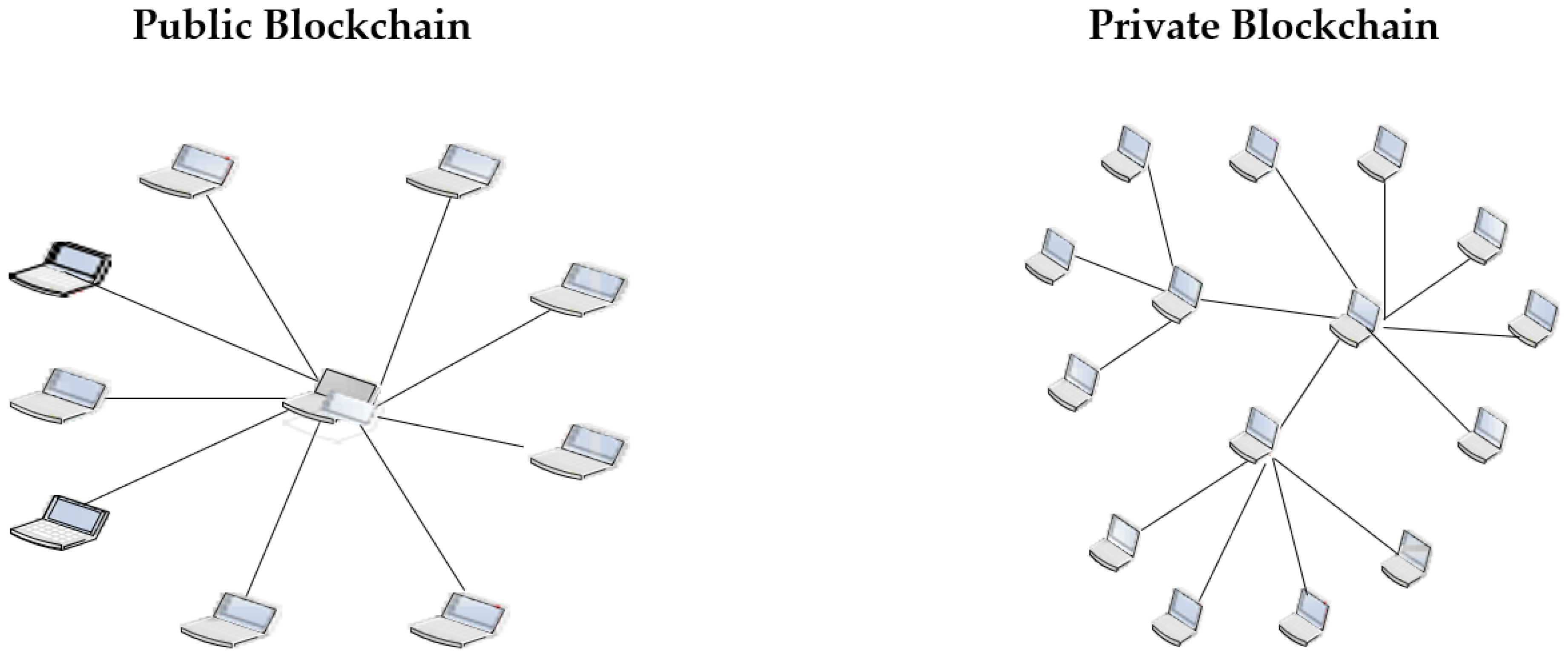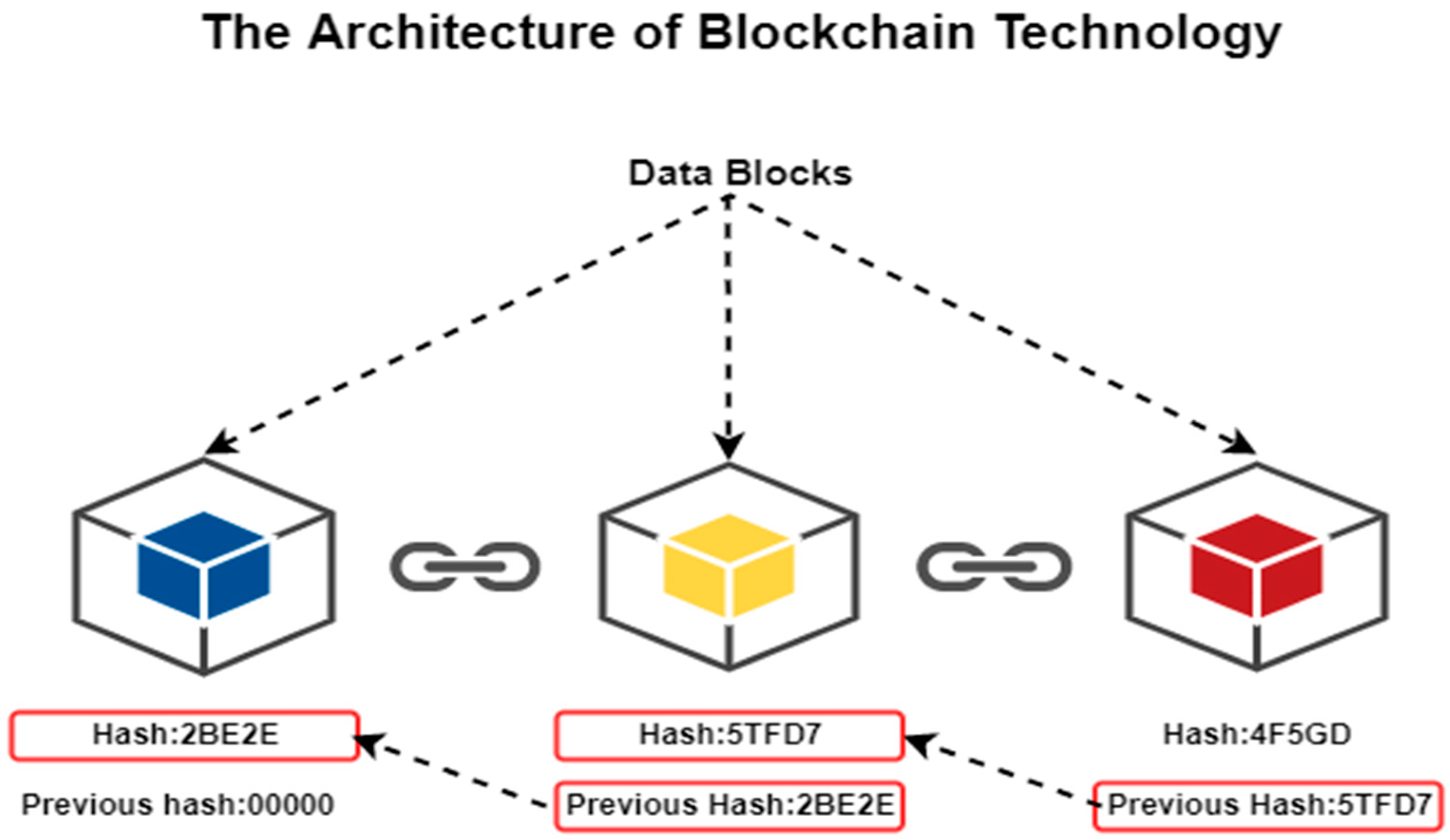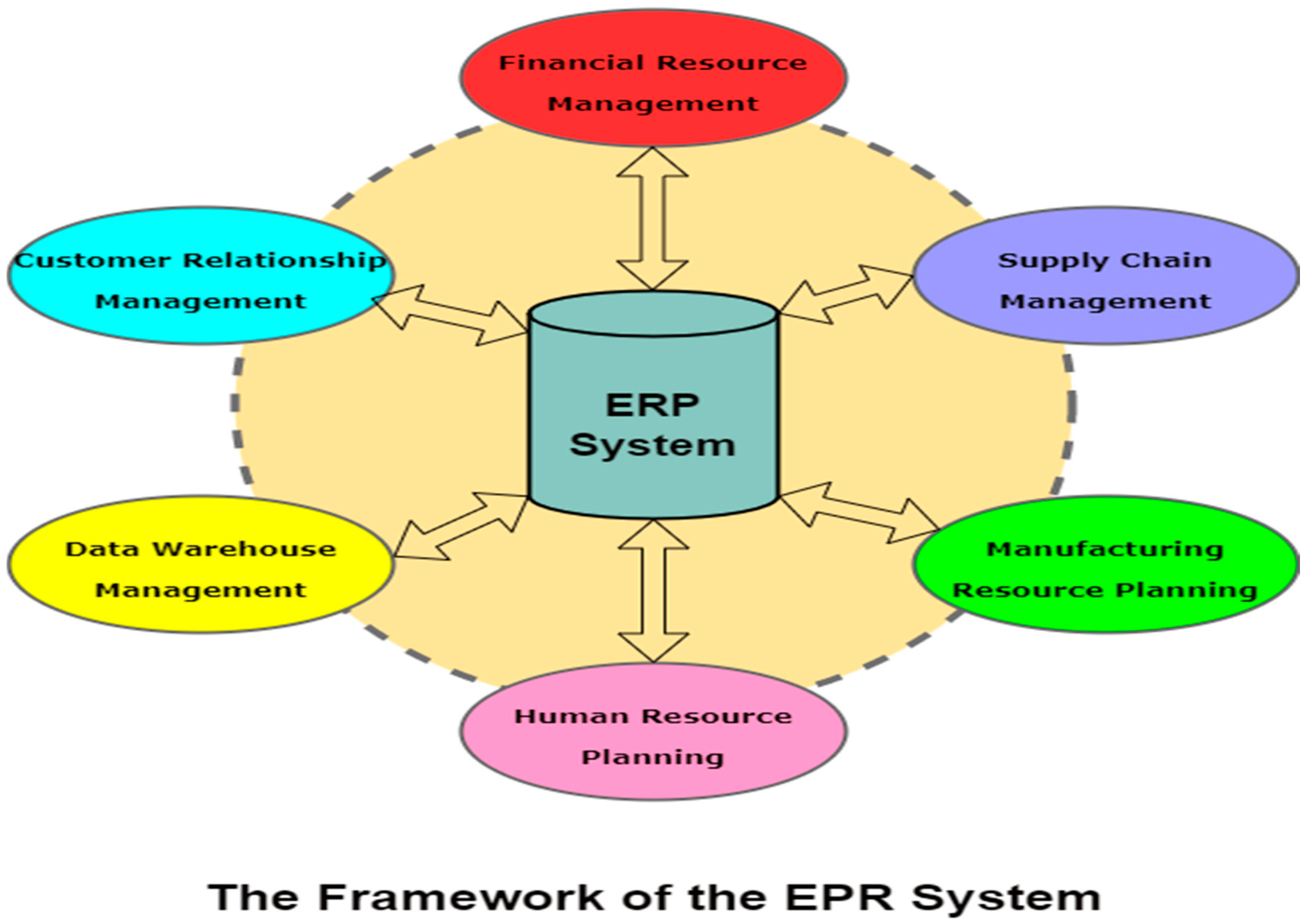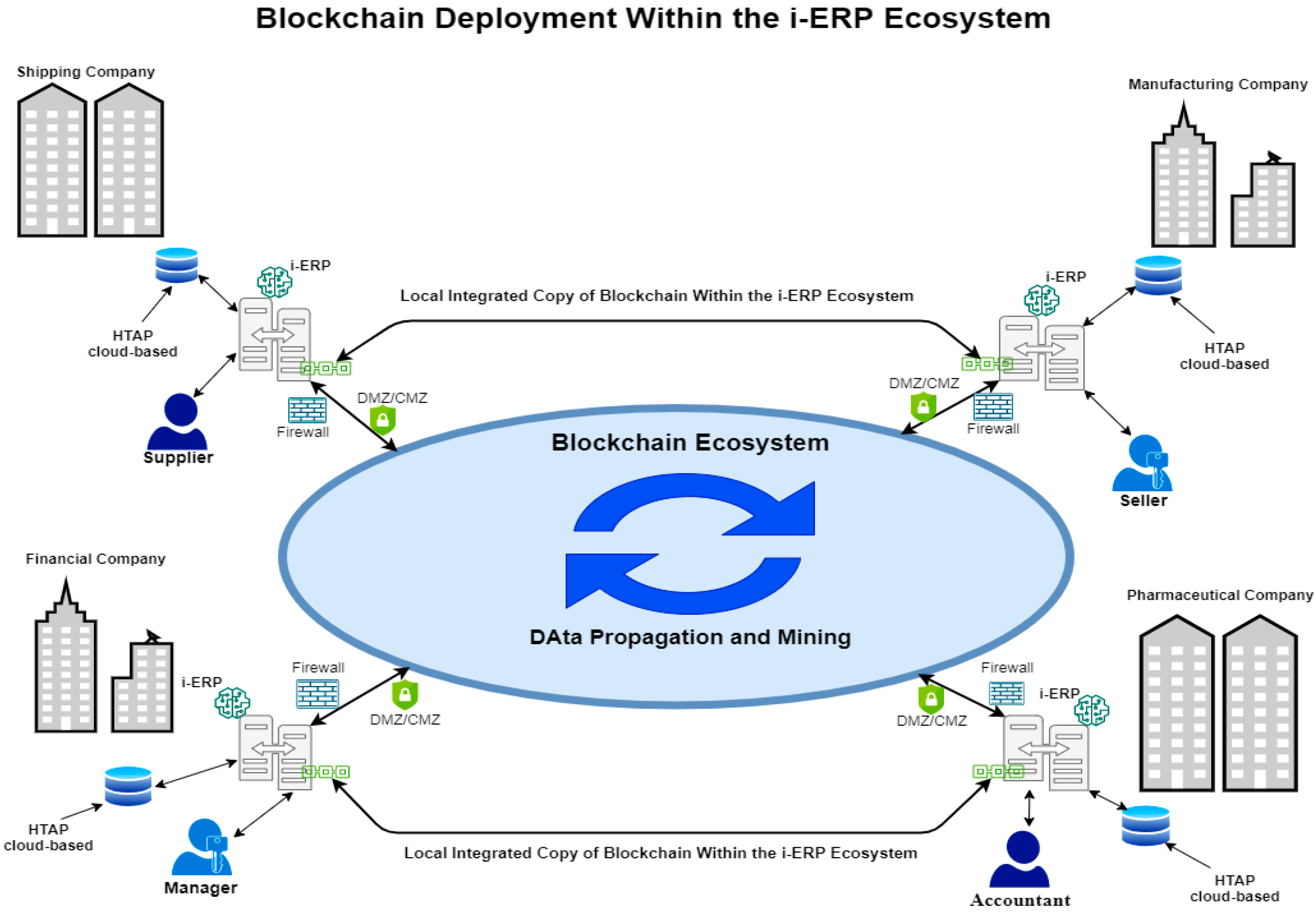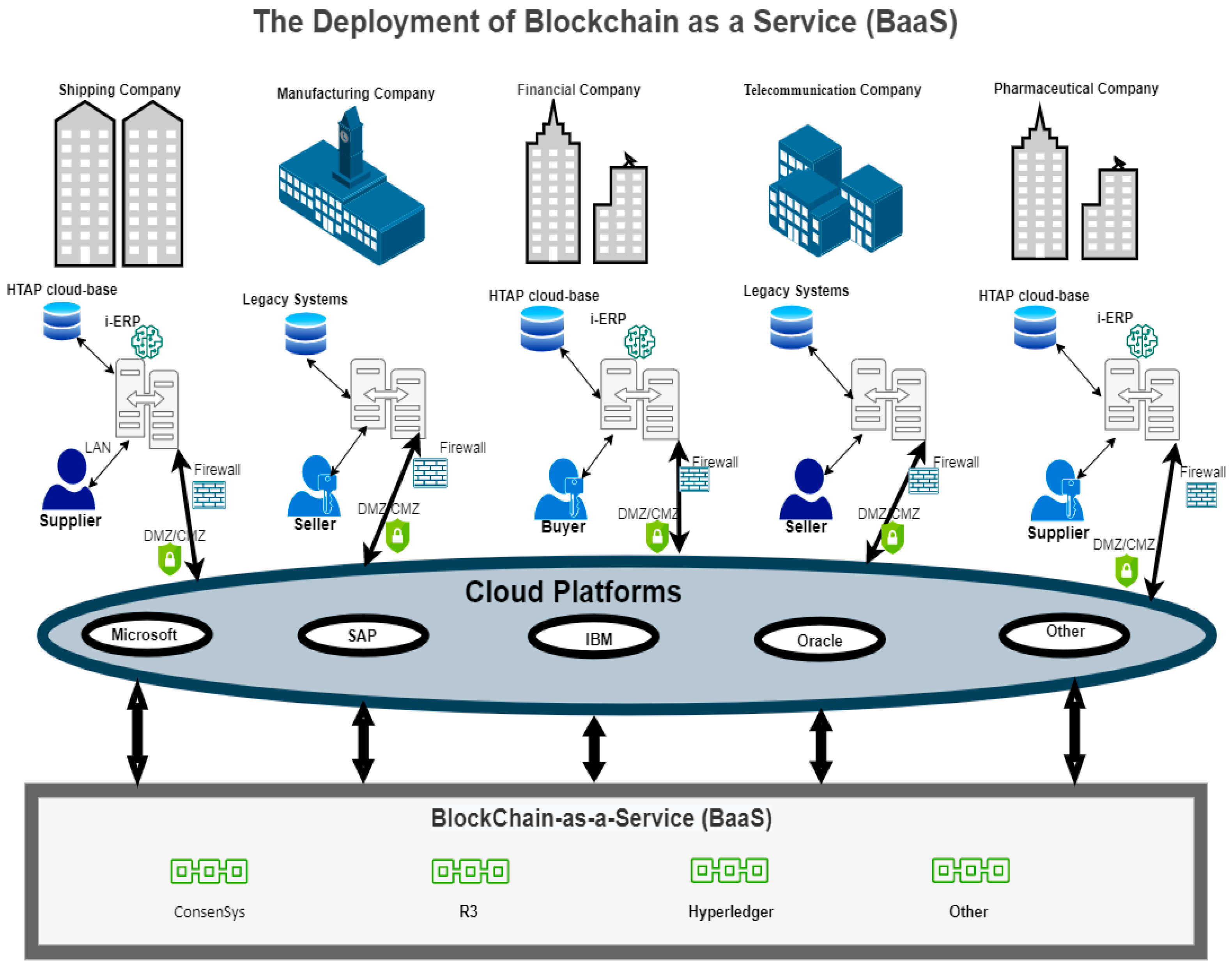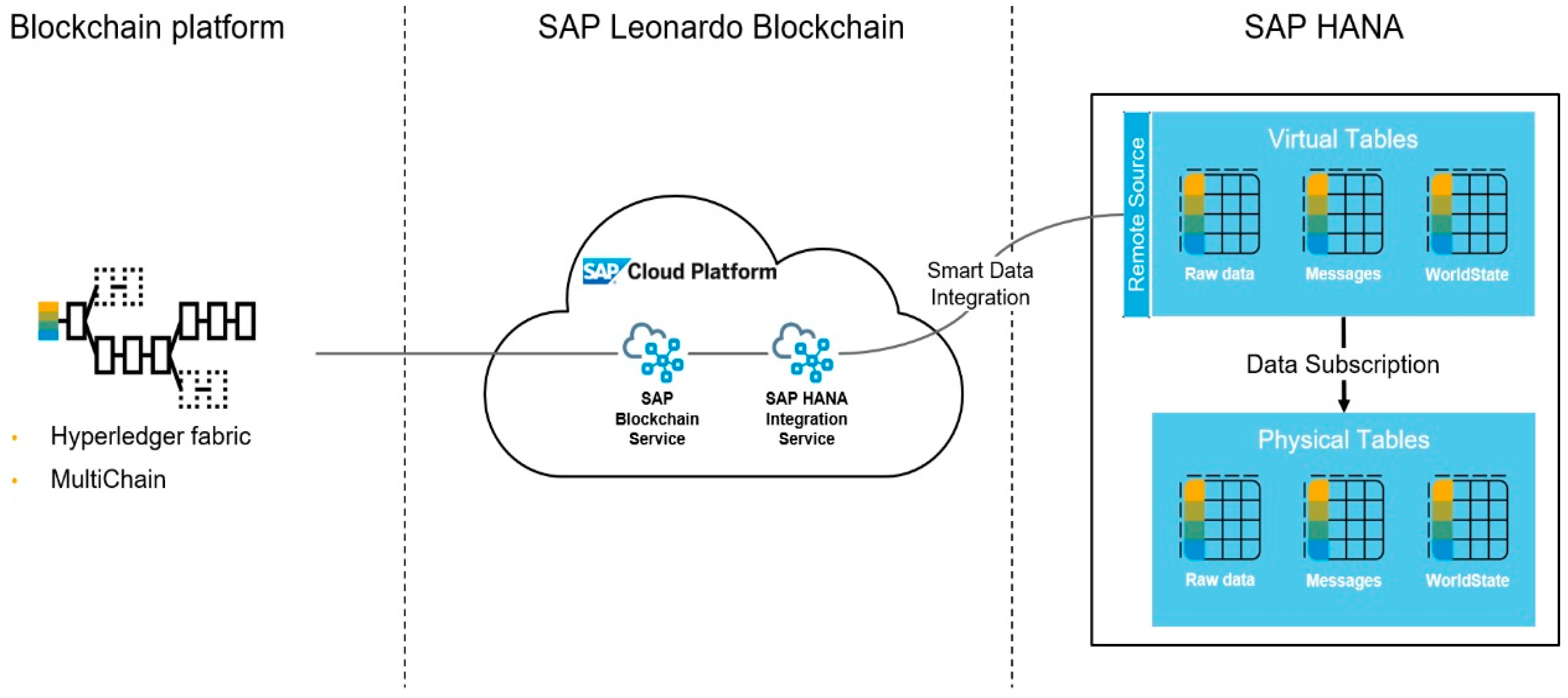1. Introduction
An Enterprise Resource-Planning (ERP) system is a centralized software, consisting of interconnected modules that work together to form a fully integrated design, management, and control system, by integrating all the business processes, activities, and functions of an organization. ERP is an essential part of an organization, as it handles and facilitates the flow of information within the organization. It affects the whole company simultaneously, rather than affecting one or more departments individually [
1]. Hence, ERP-system implementation involves a much wider organizational change, enhancing the organization’s competitiveness by improving its ability to generate accurate and timely information for managerial decision-makers [
2].
In contrast, Blockchain Technology (BT) is a decentralized and distributed revolutionary computer protocol used for the digital recording and storing of information on multiple computers or multiple nodes [
3]. BT is a distributed-ledger-recording technology that contains information about transactions or events. It can record financial transactions in a secure, transparent, decentralized, efficient, and low-cost way [
4,
5,
6]. BT does not require any centralized authority, eliminating third parties by using a consensus mechanism for updating transactions among participants in the blockchain.
Incorporating BT in ERP systems could be the next generation in business technology by reshaping organizations. Integrating BT with ERP systems will enable true data interoperability for various commercial and banking services (i.e., online payments, trade, contract management facilities, finance, and accounting). Experts indicate that it could potentially transform the business operations and functionality of organizations in a new, modern manner [
7,
8]. Tapscott and Tapscott [
9] stated that BT has the potential to become a significant source of disruptive innovations in business and management, by improving, optimizing, and automating business processes. As a result, integrating BT with ERP could enhance optimization and eventually transform the business processes of organizations. Adopting BT with ERP could increase security, speed and efficiency in transactions, transparency control, and immutability, as well as reduce costs [
9,
10]. Thus, integrating BT with ERP can secure the integrity of the transactions stored in the database, providing tools to build flexible and cost-efficient enterprise systems by using its distributed ledger, smart contracts, software connectors, and consensus mechanisms, which provide a better solution as an integration of blockchain and ERP [
11].
Moreover, BT has the ability to ensure transactional integrity and immutability increasing transactional efficiency, providing near real-time transactions, credibility, and transparency; thus, further optimizing the process of ERP systems [
12] and fully providing transparent services to all stakeholders worldwide [
13]. ERPs are centralized applications, which means that information is accessible through a centralized register.
Additionally, using BT within ERP may greatly improve the productivity, speed, flexibility, and quality of the production process [
14,
15]. Thus, given that ERP systems focus on individual enterprises, while BT integration adds more flexibility, this integration is not at the expense of security and functionality.
The purpose of the present study is to expand upon the relatively little research evidence justifying, assessing, and facilitating the integration of BT and ERP systems. Second, this study seeks to explore and analyze the main potential pillars for utilizing BT and ERP systems. Specifically, this study analyzes the available scientific literature regarding the integration of BT and ERP systems, focusing on deploying ERP Systems with built-in BT functionality and Blockchain as a Service (BaaS) with ERP systems in an ecosystem environment, from a comprehensive and interdisciplinary perspective. The paper aims to investigate the extent to which BT could be integrated with ERP systems as well as identify the limitations of this research and trends for future research opportunities. Thus, the author conducts a qualitative content analysis of an extensive sample of the literature, from 61 publications. The issues of interest were examined through an investigation of two research questions:
RQ-1. In what ways could the integration of BT influence ERP systems?
RQ-2. What are the major prospective pillars for deploying and integrating BT and ERP systems?
To address the above research questions, the following objectives are outlined:
Examine the technical and business aspects of BT and ERP systems.
Investigate the potential pillars for incorporating BT and ERP systems.
Explain the implications of implementing BT within ERP systems.
Therefore, by addressing the research questions and objectives, this study contributes to the BT and ERP literature by identifying the issues associated with integrating BT and ERP systems in businesses. It explores the potential pillars of implementing BT within ERP systems, by analyzing the main advantages and disadvantages of this emerging technology. The findings of this review could assist organizations in understanding the impact of BT in ERP systems and, thus, utilize this innovative technology by decentralizing, automating, and digitizing their business processes. Additionally, this review could motivate and assist researchers and practitioners in further exploring and developing this novel technology.
The remainder of the paper is organized as follows: a descriptive review of the literature is presented by exploring the concept of BT, the types of BT, the role of ERP systems and BT in businesses, and the major differences between ERP and BT, followed by the research gap. The following section analyzes the materials and methods of the study. The next section examines the integration of BT within ERP systems, followed by proposing the major prospective pillars for deploying BT and ERP systems. The ensuing section analyzes the obstacles and challenges in implementing BT. Finally, a section regarding conclusions, results, limitations, and suggestions for future research is presented.
2. Literature Review
2.1. Concept of Blockchain Technology
The concept of BT was devised by an unknown person using the pseudonym Satoshi Nakamoto [
16] and was initially developed as the backbone for Bitcoin as a peer-to-peer payment system based on BT. BT is the most popular decentralized digital currency [
16] and has been confirmed to be a viable solution in creating trust in a trust-less ecosystem, without a central authority for financial transactions, such as banks and financial institutions.
Figure 1 displays the architecture of BT.
Moreover, BT is an electronic ledger, similar to a relational database, which can be openly shared among public or private users, creating an encrypted, unchangeable record of transactions. Each record is time-stamped and linked to the previous one in chronological order via a cryptographic signature, so almost no one can modify or delete it [
17]. Hence, the data are immutable and once they have been written to a blockchain, not even a system administrator can modify or delete them.
2.2. Types of Blockchain Technology
There are two main types of BT networks: public and private blockchains.
Figure 2 illustrates the two main types of BT.
- (a)
Public blockchains are permissionless networks, where anyone can access and interact with transactions on the network, which is owned and controlled by no one [
18], without a central point of failure. However, a permissionless blockchain has some limits, such as its speed in processing large volumes of transactions and its vulnerability to system attacks. An example of a public blockchain is Bitcoin, which is completely decentralized.
- (b)
Private blockchains are permissioned networks with restrictions, requiring authority management and control procedures to participate in the network. In other words, permissioned blockchains are centralized networks completely controlled by organizations, so no one can participate in the network unless they have permission or an invitation. Examples of a private blockchain are MultiChain and Ripple.
Figure 2.
The two main types of Blockchain Technology.
Figure 2.
The two main types of Blockchain Technology.
2.3. Role of ERP Systems and BT in Businesses
EL Amrani, Rowe, and Geffroy [
1] defined ERP systems as commercial-software packages that provide cross-organization integration through embedded business processes, which are generally composed of several modules using a single relational database. The use of a relational database permits functional areas to share information, without having to reenter the data into separate databases, instead collecting the data once during the initial transaction, which are then stored centrally and can be updated in real time. This ensures that all levels of planning and modules are based on the same data, enabling planning and utilization throughout the whole organization.
Figure 3 illustrates the framework of the ERP system.
Therefore, most growing corporations and organizations are moving toward ERP systems, in order to integrate their cross-functional business processes. As a result, an ERP system promises greater and better information, which can lead to lower costs while integrating and automating most business processes [
19] as well as sharing information enterprise-wide in real-time. ERP systems can build business flexibility by reducing IT costs, increasing IT-infrastructure-stability efficiency [
20], improving the level of automation, reducing operating costs, eliminating unnecessary processes, and improving the accuracy and reliability of the information. This can lead to quality improvement [
21].
Moreover, an ERP system plays a critical role in modern business, especially regarding accounting function and management control. This is due to the fact that IT has radically transformed the nature of business and accounting practices [
22]. An ERP system increases performance control and enables the organization to experience an overall improvement in operational management effectiveness and efficiency [
20].
Consequently, an ERP system increases performance control and enables the organization to experience an overall improvement in operational-management effectiveness and efficiency [
20]. An ERP system can improve decision-making, reduce stock, enable better inventory, andbenefit cost management [
23]. As far as the employees who support such organizational change, it facilitates communication through common visions, improves business learning and empowerment, and increases employee morale and satisfaction [
20]. Hence, ERP systems help businesses standardize and automatize their procedures, as well as elevate management abilities for both managers and employees.
However, the nature of today’s organizations requires digitization and automatization. Industry 4.0 can be described as the digitizing of the manufacturing environment, providing communication between the factory and its environment by creating a digital value chain through automation [
24], due to the fact that it improves the flexibility, speed, productivity, and quality of the production process, while greatly increasing sustainability [
25]. In the context of Industry 4.0, [
26], a number of manufacturing models have emerged, and the development of big data, cloud computing, cyber-physical systems (CPS), the Internet of Things (IoT), and BT have become the wings of the development of smart manufacturing [
27].
Modern, intelligent ERPs have the potential to integrate the necessary functionality of Industry 4.0 and thus, new technologies have been made available to organizations in order to monitor, integrate, and trace processes through integrated digital systems. Moreover, i-ERPs could use cloud computing as a way of solving on-premise issues [
28] and combing the attached Internet of Things (IoT), so that businesses can use real-time data from any device, gain a competitive advantage, and have intelligent and more flexible ERP systems [
29]. Intelligent Manufacturing Execution Systems (MES) could also be integrated with i-ERP, providing real-time information, improving and controlling all elements of production processes [
30], and enabling decisions in near real time. Leng et al. [
31] stated that a complex network of smart manufacturing integrates advanced manufacturing technology into a new generation of information technology, and its essence is a distributed smart system with self-organization capabilities.
Nevertheless, an i-ERP that integrates Industry 4.0 requires the effective integration of many technologies and systems. Most of the existing solutions have not focused on operations across all components and systems. This creates many challenges when creating applications for smart manufacturing or for smart businesses, including security, scalability, trust, traceability, immutability, reliability, and agreement automation within the value chain.
BT could be one solution to address the aforementioned issues. According to Mutambaie [
32], BT is proving to be the fifth disruptive computing-paradigm shift. BT is a distributed, transparent, secured, and immutable record-keeping mechanism [
33], creating trust in a trustless environment. BT could fit into existing IT infrastructures utilizing middleware layers, plug-and-play web of services, and backend software [
34].
Moreover, integrating BT into an i-ERP system could support a collaborative platform, which would ensure data security, data efficiency, accuracy, transparency, and reliability. BT and ERP systems share the common feature of both being “libraries” for storing data, however, the accessibility of this data differs between the two [
35]. ERPs serve as an internal hub for all of a firm’s business activities, and it serves as a central repository for all of a firm’s data [
36]. According to Gartner [
37], the use of BT in ERP promises to change the industry by enabling confidence, providing transparency, reducing friction between business ecosystems, potentially reducing costs, reducing transaction clearing time, and improving cash flow.
As a result, ERP and BT integration enables companies to share different types of information securely and quickly, while maintaining a high level of access-control prerequisites [
38], ensuring that the data cannot be changed or manipulated. Dai and Vasarhelyi (2017) emphasize the data security and simplicity of the data-collection process, which involves no human intervention through BT, providing unchangeable transaction data records [
39]. Thus, BT has relevant operational impacts in the business, management, and accounting areas because it reduces the information-processing costs, excluding third-party involvement to verify transactions [
40], which assures enormous benefits to all stakeholders.
2.4. Main Differences between ERP and BT
ERPs are usually built upon a core of Relational Database Management System (RDBMS)—highly transactional with no computational overhead, automating the processes of various business transactions [
1] and distributing timely and accurate data that provide the basis for information analysis and management decision-making. On the other hand, BT uses a real-time scalable linear database [
41], and it has the potential to either play the role of the accounting module or be used in conjunction with the existing accounting systems. In contrast with BT, which is decentralized and distributed in different nodes, reducing the risk of a single point of failure, ERP has a centralized architecture. BT prevents unauthorized data changes using the consensus mechanism and can facilitate the tracing of tokenized objects, for instance, accounting documents, inventory items, products, and raw materials.
Moreover, ERP requires intensive human efforts. Conversely, BT is designed to operate autonomously, with little or no human intervention. Using BT and inbound smart contracts allows users to design and deploy various tasks, controls, and mechanisms on blockchain applications. Currently, BT is investing in accounting modules, instead of ERP, which is a prepackaged business software providing a fully integrated solution for enterprises.
Table 1 summarizes the main differences between ERP and BT.
2.5. Research Gap
Based on the literature review, it seems that there is a gap in the research covering aspects of BT and ERP integration, even though there is an increasing interest in the scientific community regarding the current disruptive potential of BT in various areas of the economy [
39,
42]. Therefore, this study contributes and complements the current literature in several ways. First, this paper contributes to the existing literature by offering a greater understanding of the current research by justifying, analyzing, and assessing BT and ERP systems, in terms of how BT can be applied and supported by an ERP system. Second, this study expands upon the existing literature, by exploring and analyzing a number of technical and business aspects associated with the integration of BT and ERP systems within the business environment. Moreover, this study examines and analyzes the main prospective pillars for deploying and incorporating BT and ERP systems, presenting technical details and aspects of this innovative technology, which, to the best of the author’s knowledge, have not yet been explored in the academic literature. Additionally, the study analyzes the perceived benefits as well as the obstacles and disadvantages of this emerging technology, complementing the existing literature on BT and ERP systems. Hence, the outcomes of this study may offer new pathways and insights for practice, by motivating and assisting organizations and practitioners in understanding and further exploring this novel technology.
3. Materials and Methods
The methods used for this manuscript were based on the literature review and grounded in theory. A comprehensive analysis was very important for this study because the main purpose of this research study was to unfold new knowledge based on complete data collection. The literature review attempted to examine BT integration and its potential within ERP systems. In particular, this study investigates the potential and capabilities of BT through the most recent literature, by exploring how it can be integrated into ERP systems. This study employs a qualitative-research methodology [
43]. Additionally, this study sought to gain an understanding of the published research as well as identify gaps in the current literature. The data were collected from various databases: Business Source Premier (EBSCO), Scopus Web of Science, ABI Inform (Proquest), and Google Scholar. The keywords that were used for limiting irrelevant research were: (“Enterprise Resource Planning” OR “ERP”) AND (“Blockchain Technology” OR “ledger” OR “BaaS”), (“Blockchain Technology within ERP”) AND (“Blockchain Technology and ERP”). From the initial pool, only peer-reviewed journals were considered, which directly addressed BT and ERP systems. After an extensive review validating data collection and datasets through search strings (keywords) using the title, abstracts, and keywords of entries in the databases, a total of 76 potential publications were identified for the review process, excluding journals with content that was not related to ERP, BT, and ledger. All abstracts and conclusions of the identified 76 manuscripts were read and confirmed as relevant to the research. In the literature review, all of the articles were organized by the author, using color-coding and tagging techniques [
44], so the articles were classified according to the title and/or theme and compared to what was applicable to each category. Finally, after several screenings in the review process, 63 journals were chosen and deemed relevant to this research.
Figure 4 highlights the flowchart of steps involved in the methodology.
4. The Integration of Blockchain Technology within Enterprise Resource-Planning Systems
RQ-1. In what ways could the integration of BT influence ERP systems?
ERP systems are centralized software, so expanding them to full-on ecosystems creates great challenges for the interested parties. However, integrating BT within ERP systems could help organizations move to a new era of decentralized systems, allowing stakeholders access to decentralized and distributed data. According to Sislian and Jaegler [
45] as well as Papathanasiou, Cole, and Murray [
46], different ERP systems could be interconnected via a blockchain network; thus, the blockchain may serve as a middle-ware, increasing information-sharing capabilities.
Evidence reveals that BT can also be integrated with existing ERP or legacy systems, and enable touchless-transaction processing [
47]. As a result, ERP’s processes, subprocesses, and activities could be integrated with a centralized blockchain ledger, improving the organization’s performance. Using BT, these centralized business processes become accessible across multiple organizations [
9,
48]. Therefore, BT with ERP systems allow greater control in the utilization of the existing data, concerning the generation and transfer of new information into a distributed ledger, as well as empowering businesses to have greater control over their resources by automating and digitizing their business processes, which improves performance.
According to Dasaklis, Voutsinas, and Mihiotis [
49], ERP and BT integration enhance optimization and trustworthy data exchange among organizations, especially in financial transactions. Likewise, Papathanasiou, Cole, and Murray [
46] stated that BT has the ability to trace transactions, making financial monitoring and management easier, especially when blockchain is integrated with legacy or ERP systems. Thus, by integrating BT within ERP systems, enterprises can organize and share data, where the primary scope is the performance of the ecosystem, not the individual organization, while empowering their users. Xu, Fang, and Ma [
38] stated that BT facilitates companies to share diverse types of information quickly, while maintaining a high level of access-control prerequisites.
BT ensures security and trust while performing transactions [
50]. As a result, integrating BT into an existing ERP environment can improve the automation of ERPs greatly, by creating a highly secure collaboration platform with trusted data and records that can be freely shared with trusted parties. For instance, customers or suppliers would gain full visibility and real-time information regarding payments, the tracking of raw materials, and the updating of prices or order changes in a secure environment.
Figure 5 illustrates the role of BT and ERP Systems in an ecosystem of businesses. In the following figure, the blockchain acts as a centralized distributed ledger, which has the capability to seamlessly collate data from multiple ERPs that belong to suppliers, customers, distributors, and manufacturers. In other words, the blockchain, with its distributed ledger, will act as a central backbone or as a centralized repository for all ERP partners, and, accordingly, the data that were saved into the ERP system could be channelized to the blockchain. Thus, the integration of BT and ERP can enable optimization of the operations and business processes of several different organizations as well as trusted data sharing.
Furthermore, BT is making a huge impact on manufacturing businesses, since it claims secured, transparent, and anonymized transactions [
48,
51]. This is because BT has high value and good prospects in resolving problems of data integrity, enabling easier tracking of transactions in real-time, strengthening data security, enhancing transparency across processes [
52], preventing fraud, establishing trust and privacy, and enabling greater confidence for ERP solutions.
Moreover, using a private blockchain network with smart contracts connected with ERP systems could enable real-time transactions for organizations. Smart contracts are programmable autonomous contracts, self-executed, performing the terms of a programmable contract. For instance, a blockchain using smart contracts can trigger purchase orders when stocks fall to benchmark levels or verify credible transactions without any third-party intervention. Thus, smart contracts could play a vital role in permissioned blockchain networks.
Among leading ERP vendors, SAP and Oracle seem to be getting ahead by exploring different ways of implementing BT. SAP believes that BT is perfect for manufacturing businesses, as this technology allows manufacturers to have various types of information within the same chain, for both their customers and their vendors in real-time. In the future, we might see more BT integrated into the ERP systems at many organizations and different industries such as retail, asset management, supply-chain management, production, finance, logistics, shipping, and accounting. As an example of that, Abeyratne and Monfared [
53] examined the applications of BT to supply chains in the manufacturing industry. They described the positive effects of BT on the transparency of a supply chain and the quality of products and services.
Consequently, major ERP vendors are making significant investments to integrate BT into their platforms by developing modules, layers, or interfaces to give their customers access to the new technology. An intercompany BT could reduce the time by half or more in ERP systems, such as those of SAP or Oracle, regarding purchase-agreement documents, receipt of goods and services confirmations, and payment processing. For instance, if there are subsequent change orders, each one is confirmed on the blockchain, so that there is one source of truth for that order that is visible to both parties.
Therefore, employing BT and ERP will boost the existing benefits of the ERP system to another level. BT complements ERP systems in several ways. According to the literature, BT could perform a crucial role in modern ERP systems, since decentralization and digitization are a necessity for future businesses to operate. Integrating ERP systems with BT could enable real-time applications, allow tracking of business operations in a distributed, transparent, and increase a fully auditable environment, establish trust and reliability, and resolve problems of data integrity and data quality.
Finally, so far, BT seems to be an additive technology that will not replace the need for internal ERPs. However, BT can support a spectrum of emerging technologies, such as cloud computing, the IoT, CPS, predictive analytics (PA), ML, adaptive robotics, industrial integration, and AI, by incorporating Industry 4.0. Thus, integrating BT within ERP could extend and support a number of emerging technologies in an ecosystem, to strengthen the integrity and the business automation of several fields.
5. Major Prospective Pillars for Deploying BT and ERP Systems
RQ-2. What are the major prospective pillars for deploying and integrating BT and ERP systems?
There are two main potential growth pillars to be explored and analyzed regarding the deployment of BT and ERP systems: the advent of the built-in blockchain functionality within Intelligent ERP (i-ERP) systems and the Blockchain as a Service (BaaS) with ERP systems, for deploying an ecosystem.
5.1. Deploying i-ERP Systems with Built-in BT Functionality
When deploying i-ERP systems with built-in BT functionality, BT will function as a layer complementing the existing i-ERP systems or incorporate BT into the systems themselves. In the following deployment, an i-ERP system is incorporating BT within a collaborative business-to-business (B2B) model, which is shown in
Figure 6. A modern i-ERP will have the ability to communicate simultaneously with multiple blockchain networks in an ecosystem of businesses, creating B2B collaboration opportunities above and beyond collaborative sales, distribution, billing, global-inventory management, assets, cost accounting, audits, shipments, tracking, customer feedback, and records management.
This figure highlights the capability of the built-in blockchain functionality, within i-ERP systems in an ecosystem environment. Specifically, the deployment could be implemented on the cloud, rather than on proprietary server infrastructure (on premises), using cloud computing (containing data storage, database, and operating systems in the cloud) needed for supporting the functionality of i-ERP, with the embedded BT maintaining its own local copy of the entire blockchain at all times.
Moreover, the architecture of the i-ERP/blockchain ecosystem could be in a cluster configuration for better load balancing and high availability, by running a hybrid transaction/analytical processing (HTAP) database, supporting both day-to-day operations and transactions as well as performing analytical processing for managerial analysis and decision-making.
Furthermore, i-ERP systems with built-in functionality for BT can be deployed as part of a private, permissioned blockchain network. For security purposes, it can be deployed behind the participant’s internal firewall and the perimeter of a demilitarized zone (DMZ) or a classified militarized zone (CMZ). Thus, authorized users will be allowed to log in using ethernet or via wireless access on a cloud-based network. The entire blockchain itself propagates, depicted as a large oval ring in the center, forming a peer-to-peer network. As a result, each business entity is maintaining its own local copy of the entire blockchain ledger at all times, and all members will retain ownership of the complete blockchain at the same time, according to their authorizations in the blockchain network.
Additionally, a plethora of technical components, such as AI, which the fourth industrial revolution is using, could be integrated with i-ERP and BT to gather data collected across the entire business entity through the IoT. Smart sensor technologies can be combined with the Industrial Internet of Things (IIoT) via robotic process automation (RPA) and through PA, in order to examine datasets and draw conclusions regarding that information [
54]. Thus, a modern i-ERP with built-in BT functionality can minimize human error, assist in data entry, monitor inventory, and keep track of a vast spectrum of tasks in real time, enabling counterparties to focus on more important tasks as well as enhance the overall productivity and performance of the business entity.
5.2. Blockchain as a Service (BaaS) with ERP Systems for Deploying an Ecosystem
Blockchain as a Service (BaaS) is a combination of cloud-based hosting services that allow businesses to develop, host, and manage their own applications, nodes, smart contracts, and distributed ledgers in a cloud ecosystem, which is managed and administered by cloud-based providers. In other words, BaaS acts as a bridge between enterprise and blockchain platforms. Some of the main providers offering BaaS are Microsoft, IBM, Oracle, and SAP. BaaS providers manage all of the necessary tasks and activities to keep the infrastructure stable, operational, and accessible, by simplifying the operation process and reducing deployment costs, with the intention of bringing convenience to developers as well as ensuring the reliability and security of their blockchain applications.
Figure 7 highlights the deployment of BaaS.
Therefore, BaaS providers are the crucial key factors for large-scale blockchain adoption among businesses, as they enable enterprises to adopt BT without having to spend anywhere near as much money as they would have to if they were to develop blockchain solutions on their own. However, BaaS providers often lack reliability and scalability of their BaaS infrastructure, which is critical for companies that are planning to adopt share ledgers within a network of BaaS providers.
Table 2 presents some of the major providers of (BaaS).
An example of BaaS is the SAP Cloud Platform (SCP) blockchain, using SAP Leonardo solutions.
Figure 8 illustrates the architecture of SCP Blockchain as a service connecting the SAP HANA database with the SAP HANA DLT blockchain service (a decentralized database) and the cloud-computing SAP Leonardo Blockchain with existing blockchain platforms such as Hyperledger Fabric or MultiChain.
These components ensure that transactions on blockchain platforms (e.g., Hyperledger or MultiChain) are also backed up on SAP HANA. This linkage is carried out in two dimensions, in other words, a transaction made on SAP HANA will also be backed up on the blockchain and can be accessed by other applications. A blockchain can be deployed on an independent infrastructure and connected to SAP applications via the SCP blockchain, or it can be installed right on the SAP HANA Cloud Platform. In this way, transactions made via ERP, business warehouse management (BWM), customer relationship management (CRM), and supply chain management (SCM) could be recorded by BT to promote the advantages of this technology. Another example of this is Microsoft’s Azure cloud-computing platform connectivity to management applications, such as Microsoft Dynamics 365, or applications of third parties using the Ethereum blockchain.
6. Obstacles and Challenges in Implementing Blockchain Technology
Despite the number of obvious advantages of integrating BT and ERP systems, there are also a lot of drawbacks:
The immaturity of BT itself in this early stage of development and the lack of experiential knowledge, since it represents a complete shift to a decentralized network, and security vulnerabilities could lead to some ambiguities in adopting and implementing the technology [
18].
BT must prove its scalability, viability, and its speed in different cases [
55].
Cyber-security issues and threats exist regarding the privacy of organizational information [
56,
57,
58].
Interoperability, by migrating or moving ERP and legacy systems, requires a significant amount of investment in the infrastructure of an organization. [
57,
59].
Given a lack of global regulatory context for BT [
60], there is little to no governance at all for BT from any international framework or law.
Sufficient bandwidth and capacity are required to ensure that all records and data will be transferred completely on time [
61].
The computational power required for blockchain processing, memory, data storage, data management, anonymity, and irreversibility as well as the related electricity consumption, are issues that need to be resolved [
58].
7. Conclusions, Results, Limitations, and Suggestions for Future Research
From a theoretical point of view and based on the literature review, this paper demonstrates important theoretical contributions to the symbiotic association among ERP systems and BT. The study has clarified and justified several aspects of technical and business futures, the potential benefits and drawbacks, and the pending challenges of this innovative technology, though little is known about BT and ERP systems.
This research has explored the capabilities and potentials of BT associated with the integration of ERP systems. The results indicate that BT’s distributed nature, consensus mechanism for updating transactions, immutable record keeping, interoperability, access control, provenance, and data integrity could improve ERP greatly. According to the study, integrating current ERP with BT could improve optimization, increase security in transactions, transparency control, and create trust in a trustless environment. Moreover, BT integration enables robustness and fault tolerance, providing real-time transactions, credibility, and reliability, which optimizes the process of ERP systems.
Specifically, the author analyzed the integration of BT and ERP systems, which can revolutionize automation and digitization as well as reinvent the related business processes and operations of organizations. Additionally, incorporating ERP systems with BT may provide greater visibility for a wide range of activities, functions, and processes, extending the boundaries of ERP across different entities that may or may not eliminate the need for intermediaries. The author then discussed and clarified the possible adoption of Industry 4.0 within BT, to extend ERP’s possibilities and improve the different processes within the manufacturing value chain, thus increasing efficiency and profitability. Therefore, it could meet the expectations and exceed the information needs of all the stakeholders in the enterprise, in terms of information availability, security, and quality. Additionally, the author explored and analyzed the primary potential development pillars of BT and ERP, providing both the technical characteristics as well as the business aspects. Finally, the study examined the potential benefits, challenges, and drawbacks of this innovative technology.
Moreover, this paper not only has the theoretical significance of contributing to the BT and ERP fieldbut also makes practical contributions by examining two intersecting developmental pathways: (a) the advent of built-in blockchain functionality within i-ERP systems and (b) the development of Blockchain as a Service with ERP systems. Therefore, the proposed classification framework may inspire and assist researchers, developers, and practitioners to further develop and implement this technology.
However, there are two main limitations in this research study, regarding the deployments of BT and ERP systems. The recommended deployments that have been proposed and analyzed are partially in theory, so would need to be developed further by designing, analyzing, and implementing properly, in order to be applicable in enterprises. The second limitation is the maturity of the proposed technology itself, since BT represents a complete shift to a decentralized and distributed technology.
Hence, this technology is still in its early stage, so more empirical evidence is needed to examine both BT and ERP systems. As a result, it is possible to indicate a number of issues for future research. Future research is required to explore and understand this innovative technology, by analyzing more intensively the integration of BT within ERP systems and the related implications for businesses. More research is needed to investigate the framework of BT’s cyber-security features and its implications for the privacy of organizations. Research would need to examine the interoperability of BT and ERP or legacy systems regarding customization and migration issues as well as resolve technical issues, as BT is a new decentralized and distributed technology. Future research is required to examine Industry 4.0 regarding its components of cloud computing, the IoT, CPS, PA, ML, and AR as well as AI through BT and intelligent ERP systems. Future research might investigate the potential Reference Architectural Model for Industrie 4.0 (RAMI 4.0), which consists of a three-dimensional coordinate system that contains the essential aspects of Industry 4.0, a common model for systematizing, structuring, and mapping the complicated relationships and functions needed in Industry 4.0 applications or the model of the Data Management Body of Knowledge (DAMA-DMBOK), which describes the logical progression of steps for constructing a data management system; thus, BT and ERP systems could be included in these models.
Moreover, BT’s nature represents a complete shift to decentralization and digitalization, so it might fit well with the concept of the Ralph Kimball data model, which follows a bottom-up approach to data-warehouse architecture and can be used to organize distributed-information warehouses. As a result, future research should take into consideration factors such as price, expediency, and the challenges of developing systems regarding the above models. Finally, more intensive research is needed to advance the maturity of this area and resolve regulatory issues among regulators, auditors, and public administrators, regarding this emerging technology.
